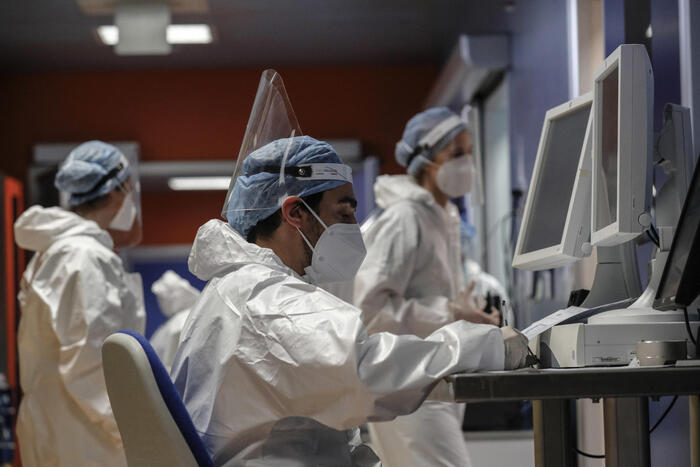There are 71,947 new infections from Covid recorded in the last 24 hours,
according to data from the Ministry of Health.
A figure that brings the current positives to more than one million people (1,037,511).
Yesterday 84,700 were infected.
The victims are instead 57
, compared to 63 yesterday.
A total of 262,557 swabs were performed, including antigenic and molecular, with the positivity rate of 27.4%, a slight increase compared to 26% yesterday.
291 patients are hospitalized in intensive care, 16 more than yesterday.
The daily admissions are 40. The hospitalized in the ordinary wards are 7,212, 177 more than yesterday.
THE EXPERT'S OPINION
- The real cases of Covid-19 in Italy could be equal to 5% of the population, or about 3 million: this is the probable estimate, according
to epidemiologist Carlo La Vecchia,
professor of Medical Statistics at the University from Milan.
"If we think about an estimate of real cases, it is likely that today
at least 5% of Italians are positive
," La Vecchia told ANSA.
A percentage that translates into "a number between 2 and 4 million individuals, probably around 3 million".
Against the million known cases, there would therefore be "about 2 million unregistered cases, probably with few or no symptoms".
This situation is the consequence of the fact that the sub-variant Omicron BA.5 "is one of the most contagious viruses ever seen"
, with a base reproduction number R0 of around 20 ". That is to say that each infected individual can cause an average of 20 new infections, and this" makes tracing virtually impossible, "observed La Vecchia. 19 in Italy began to rise for about a month, with a 28% increase recorded in the first week of June up to + 60% in the third week, followed by an increase of 53%: "in the light of these data, it is beginning to see a flattening of the registered infections, but the real ones are enormously more ". This is indicated, for example, by the positivity rate up to 27%, which results from the ratio between the number of cases and tests, which are about 300,000 per day, "a low number compared to the million a day last January.
To get them - said the
Even in light of these data, it is clear that the one million Covid-19 cases registered in Italy are far from reality.
As for hospitalizations, according to La Vecchia, the numbers are still far from the threshold values: the over 7,000 in the ordinary wards correspond to about 10% of the available beds, and the 275 hospitalized in intensive care units occupy about 3% of the beds. available.
The weekly average of deaths is 60, equal to 3% of the total deaths in Italy.
For the deaths, as for the hospitalized, "in part they occur for other causes, and then they also have Covid".
SINGULAR SUMMER WAVE -
This summer wave of Covid-19 is decidedly 'singular', with a decidedly high circulation of the SarsCoV2 virus and a progressive increase in cases: a typical trend of an ongoing epidemic and far from that of an endemic phase .
This was revealed by the epidemiologist Carlo La Vecchia, professor of medical statistics at the University of Milan.
"Seeing such a vehement epidemic in the summer is singular. We know - the expert told ANSA - that summer makes the transmission of respiratory viruses more difficult, but what is happening reflects the contagiousness of this virus".
So much so that to have another example of an epidemic caused by such a strong respiratory virus during the summer, we need to go back to the first wave of the Spagnola, of which, however, we have no data on the contagiousness.
It is difficult at the moment, continued the expert, to make predictions on the progress of the epidemic.
The wave caused in January by the arrival of Omicron, but in which the Delta variant was still present, had led to 20,000 hospitalizations;
the second wave, in March, at around 10,000: "if things now go as in March, this new wave could begin to level off in the next few weeks, around mid-July," La Vecchia observed.
But we have to deal with the anomaly of the high circulation of the virus in the summer.
If on the one hand the summer heat could still buffer a virus that is transmitted very easily ", on the other hand, not using masks and having everything reopened favors the circulation of a virus so contagious that it is compared to measles. now it is difficult to be able to use all the containment measures: either these are used in a rigid way, or - he observed - we have to live with the virus ".
However, we are not in a condition of endemic because, La Vecchia said, "endemization means that there is a low state of circulation of the virus, which is not eliminated. Now, however, we are seeing continuous epidemic peaks".
Even this wave caused by Omicron BA.5, she concluded, "could run out in two or three months, the problem is to see what will happen with the
ANSA agency
Covid: 84,700 positive, 63 deaths.
118, cases of pneumonia increase - Chronicle
26% positivity rate.
Emergency service manager: responsible for pneumonia is the most recent of the Omicron sub-variants, BA.5 (ANSA)















